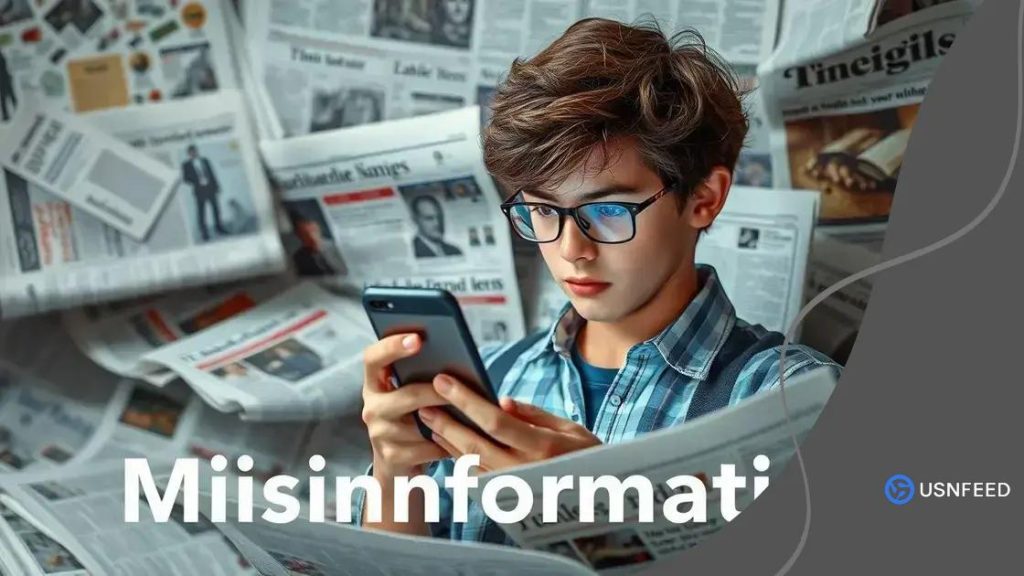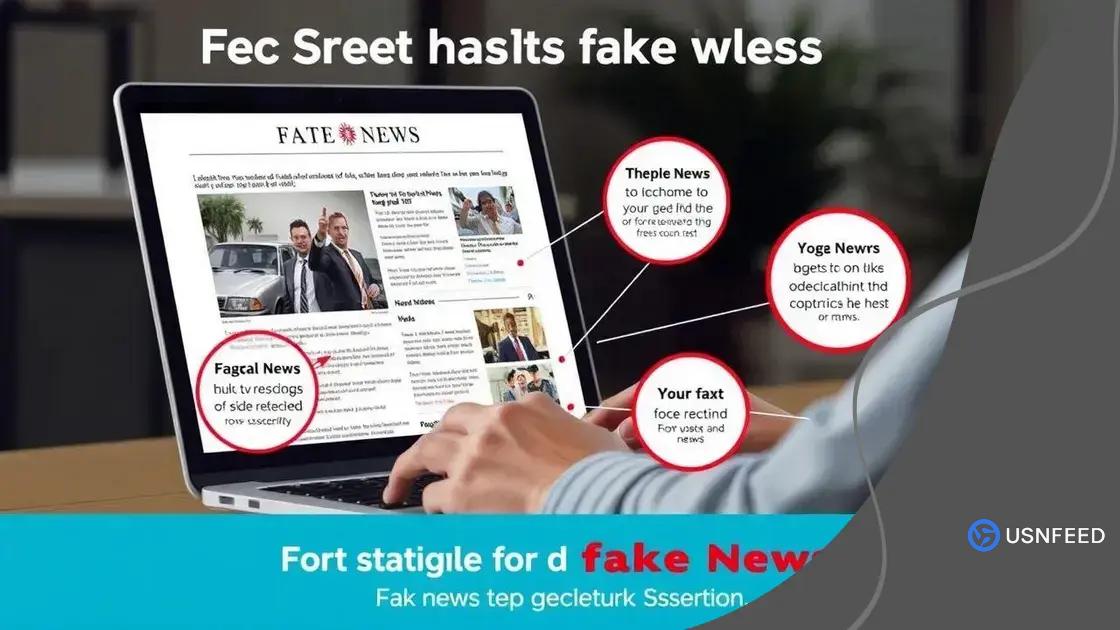Media and misinformation challenges: navigating the truth

Media literacy empowers readers to critically evaluate information, identify credible sources, and combat misinformation, ensuring a more informed society.
Media and misinformation challenges are more prevalent than ever. In an age where information travels fast, it’s crucial for readers to discern fact from fiction. Have you ever wondered how misinformation shapes your views?
Understanding misinformation in media
Misinformation in media is a serious issue that affects how we perceive the world around us. It can spread quickly and mislead people. Understanding how to identify and combat misinformation is essential.
What is misinformation?
Misinformation is false or misleading information spread regardless of intent. It can occur in news articles, social media posts, and casual conversations. The rapid growth of technology and social media platforms has exacerbated the problem.
Why does misinformation matter?
The consequences of misinformation can be severe. It can influence public opinion and shape behaviors. For instance, during health crises, misinformation about treatments can lead to harmful decisions.
- Misinformation can undermine public trust.
- It often prevents individuals from making informed choices.
- Misinformation contributes to societal divisions.
Recognizing the signs of misinformation is crucial. Often, misinformation is crafted to evoke strong emotional reactions or to support a specific agenda. Look for sensational headlines and confirm the credibility of sources.
How to spot misinformation
There are a few key strategies you can employ to identify misinformation:
- Check the source: Is it reputable?
- Look for citations: Are claims backed by evidence?
- Examine the date: Is the information current?
By being proactive and critical about the information you consume, you can help yourself and others navigate the complexities of media and misinformation challenges.
Impact of misinformation on society
The impact of misinformation on society is profound and far-reaching. It can distort public opinion and influence decisions on critical issues such as health, politics, and safety. When false information spreads, it can create confusion, fear, and mistrust among communities.
Public health and misinformation
During a health crisis, like a pandemic, misinformation can have deadly consequences. People may ignore legitimate health advice, believing false claims instead. This not only endangers individual health but can also strain health systems.
- Incorrect information about vaccines leads to hesitancy.
- Unproven treatments can put lives at risk.
- Misinformation can create panic during emergencies.
Additionally, misinformation can undermine trust in health experts. When individuals encounter conflicting messages, they may become skeptical of all information they receive, including accurate data.
Political effects of misinformation
Misinformation can also have significant political ramifications. It can sway elections and shape public policy. False narratives are often circulated to discredit political opponents or to promote specific agendas.
- Fake news stories can go viral, misleading voters.
- Unsubstantiated claims can increase polarization.
- Misleading advertisements can manipulate public perception.
This environment makes it difficult for citizens to engage meaningfully in democracy. Voter apathy may arise when people feel overwhelmed by conflicting information.
The societal effects are not contained to just health and politics. Misinformation can fracture communities, encouraging division and hostility. As individuals become more isolated in their beliefs, they may stop engaging with opposing views, further entrenching their perspectives.
Strategies to identify fake news

Identifying fake news is crucial in today’s fast-paced information age. With the spread of misinformation, knowing how to spot unreliable content can help protect ourselves and our communities. Here are some effective strategies to discern fact from fiction.
Check the source
The first step in identifying fake news is to evaluate the source. Reputable news outlets usually adhere to journalistic standards. Look for established organizations that are known for their credibility.
- Verify the author’s credentials.
- Check if the organization has a solid reputation.
- See if the article is published on an official website.
Using trustworthy sources significantly reduces the chances of encountering misinformation.
Analyze the content
Next, take a closer look at the content itself. Be skeptical of sensational headlines or exaggerated claims. These are often red flags that the information may be misleading.
- Look for factual support in the article.
- Verify the information with multiple sources.
- Evaluate the tone; is it overly emotional or biased?
A critical approach to the content can reveal inconsistencies or unsupported statements that may indicate fake news.
Cross-check facts
Another effective strategy is to cross-check facts. Utilize fact-checking websites to confirm controversial claims. These independent organizations specialize in verifying information and often provide clear assessments of news reports.
By relying on these resources, individuals can better navigate the complex landscape of news. Additionally, share your findings with others to help them stay informed. As more people learn to identify fake news, the impact of misinformation on society will diminish.
The role of technology in news dissemination
Technology plays a vital role in the dissemination of news today. The rise of the internet and mobile devices has transformed how information is shared and consumed. News travels faster than ever, reaching audiences almost instantaneously.
Instant access to information
With the click of a button, people can access news updates from around the world. This instant access allows for real-time reporting, enabling readers to stay informed about unfolding events. Social media platforms further amplify this process, allowing users to share news quickly.
- Platforms like Twitter and Facebook allow for rapid sharing.
- Mobile apps provide notifications for breaking news.
- Podcasts and video updates give varied options for news consumption.
However, this speed can also lead to challenges. The rush to report can result in inaccuracies, as news organizations may publish information before thoroughly verifying facts.
Algorithms and personalization
Another significant aspect is the use of algorithms to personalize news delivery. Many news apps and social media sites curate content based on user preferences, which can create echo chambers.
- Algorithms prioritize what users are likely to engage with.
- This can lead to a narrow view of current events.
- Users may miss important stories that do not align with their interests.
While personalization helps tailor the news experience, it raises concerns about exposure to diverse viewpoints. Technology’s impact on news dissemination demonstrates both its power and its pitfalls.
Despite the challenges, technology also offers tools for critical evaluation. Fact-checking websites and apps assist readers in verifying information before sharing it. By leveraging these resources, individuals can contribute to a more informed public.
Building media literacy for readers
Building media literacy for readers is essential in today’s digital landscape. As misinformation continues to proliferate, understanding how to critically evaluate sources becomes crucial. Media literacy empowers individuals to navigate complex information environments effectively.
Understanding media literacy
Media literacy involves the ability to access, analyze, evaluate, and create media. It equips readers with the skills to discern credible information from falsehoods. By fostering these skills, we help cultivate a more informed society.
- Access information: Know where to find reliable news.
- Analyze content: Evaluate the intent and perspective in media.
- Evaluate sources: Check author credentials and publication reputation.
This understanding encourages readers to be more discerning, allowing them to make informed choices about the information they consume.
Strategies for building media literacy
There are several strategies to enhance media literacy among readers. Engaging in discussions about media content is an effective way to develop critical thinking skills.
- Hold group discussions about current events to analyze different perspectives.
- Use practical exercises, like identifying biases in articles.
- Encourage participation in workshops focused on media literacy.
Such activities promote collaborative learning and reinforce critical thinking.
In addition, integrating media literacy into educational curriculums is vital. Schools can include lessons on recognizing credible sources and understanding media bias. This foundation ensures that students grow into informed, responsible consumers of information.
Moreover, adults can improve their media literacy by actively seeking resources. Online courses, articles, and podcasts about news literacy can provide valuable insights. As people become more aware of biases and misinformation, the overall quality of public discourse can dramatically improve.
In conclusion, building media literacy is essential in our digital age. It helps individuals critically evaluate the information they encounter daily. By teaching readers to identify credible sources and understand the effects of misinformation, we can empower them to engage thoughtfully with news. Promoting discussions and education about media literacy will create a more informed society, reducing the impact of false information. As we all work together to sharpen our media skills, we can ensure a healthier information environment for everyone.
FAQ – Frequently Asked Questions about Media Literacy
What is media literacy?
Media literacy is the ability to access, analyze, evaluate, and create media. It helps individuals discern credible information from misinformation.
How can I improve my media literacy skills?
You can improve your media literacy by engaging in discussions about media content, attending workshops, and using online resources focused on critical analysis.
Why is understanding misinformation important?
Understanding misinformation helps individuals make informed decisions and fosters a more knowledgeable society, reducing the influence of false information.
What role do discussions play in media literacy?
Discussions allow individuals to share perspectives, analyze different viewpoints, and enhance critical thinking skills, which are essential for media literacy.